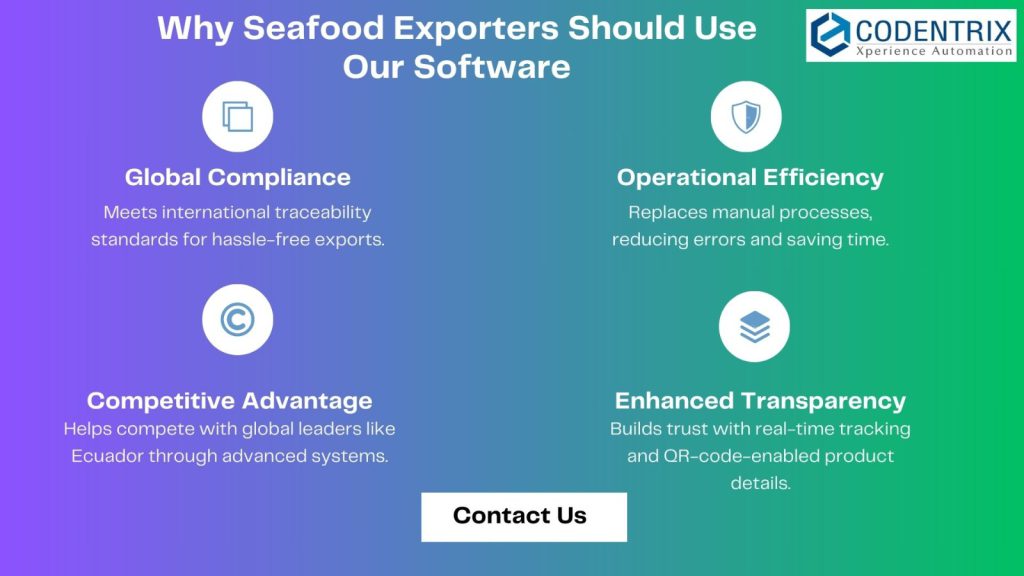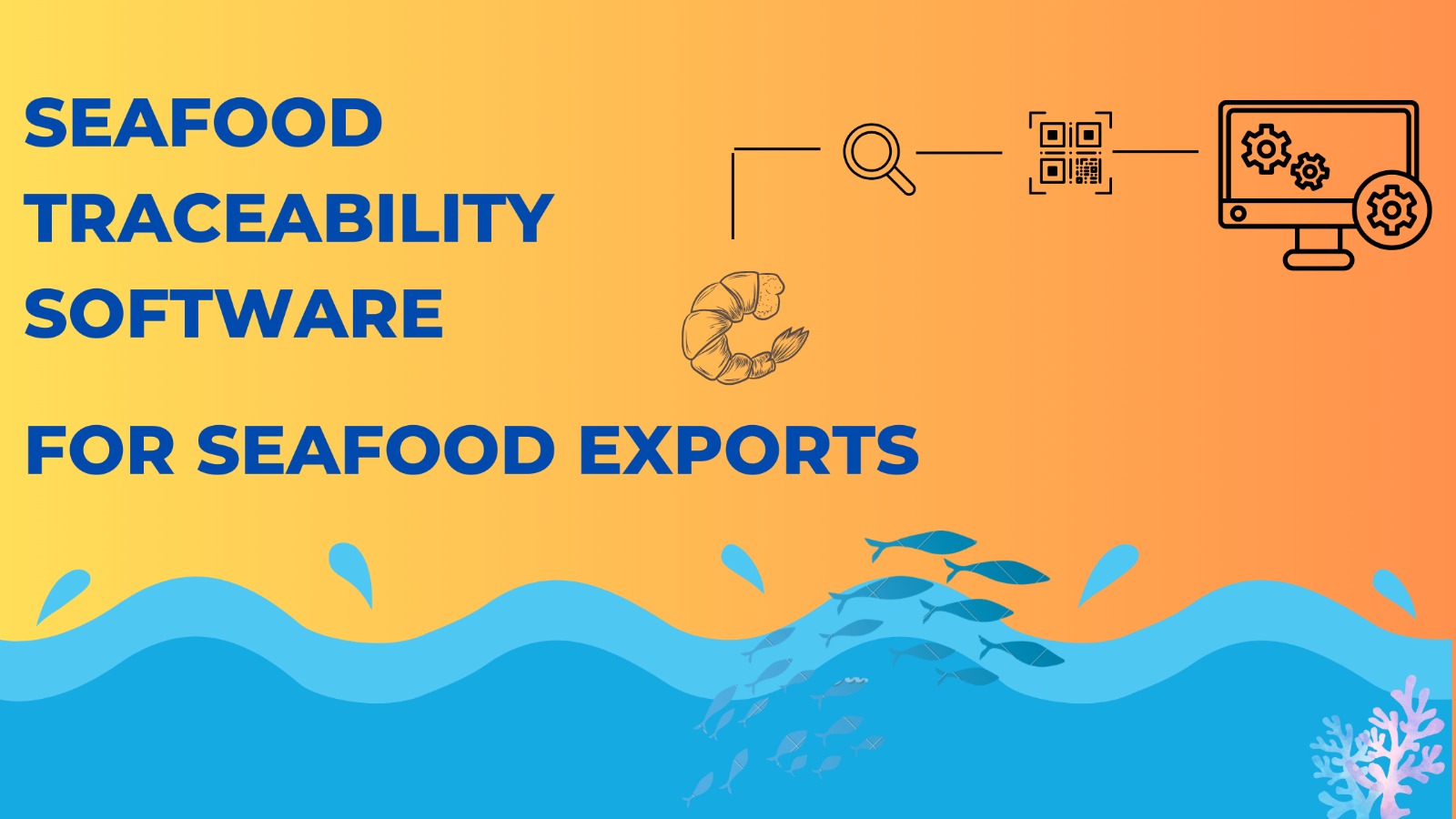Unlocking Global Markets for Shrimp Exports.
India is one of the largest seafood producers and exporters globally, second only to China. Shrimp exports alone account for approximately 70% of the country’s marine exports. The seafood exports from India has substantially increased over the last 10 years and until 2021, India led the world in shrimp exports, holding a 20% market share. However, this leadership has been temporarily overtaken by Ecuador due to logistics challenges during the COVID-19 pandemic. Ecuador has been able to capture the US market due to proximity and US was the leading importer of shrimp from India. Seafood Traceability Software is becoming increasingly essential to meet global regulatory requirement and to regain India’s competitive edge by ensuring transparency and compliance in shrimp exports.
The Indian shrimp industry is influenced by various factors, including climatic conditions, infrastructure limitations, and technology gaps. These factors affect our country’s growth and competitiveness in the global market.
Let us for the purpose of todays discussion focus on the Traceability gaps and global competition in the Indian Shrimp Industry and how we can address this to unlock the Global market for Shrimp exports for the India Shrimp producers.
- Traceability Gaps: The International market expects a reliable track and trace system to be in place, in production and along the supply chain to verify the authenticity of the product. The global market expects the Indian producers, to have a traceability mechanism to verify the product origin, quality of the product, and sustainability. In India, many shrimp farms and processing units still rely on manual and paper based systems which are cumbersome, inaccurate and which fail to provide real-time, transparent information. Seafood Traceability Software can bridge this gap by offering automated solutions for tracking and maintaining accurate data.
- Global Competition: Countries like China and Ecuador have streamlined their processes, using advanced traceability systems, efficient farming methods, and strong infrastructure to gain a competitive edge. Incorporating Seafood Traceability Software can help Indian producers match these advancements and regain market share.
Closing this gap will be economically beneficial for us to retain and regain our global market share in shrimp exports. Strengthening traceability systems will enable Indian shrimp manufacturers to build consumer trust, enhance product value, and compete more effectively in the global market.
How Ecuador Became the Leading Shrimp Exporter
Ecuador’s shrimp industry has been growing rapidly, surpassing India to lead the global shrimp market. Ecuador’s share grew from 9.4% in 2013 to 30.7% in 2022, and it currently holds 30% of the global market share.
Key reasons for Ecuador’s success include:
- Robust Traceability Systems: Ecuador implemented advanced traceability solutions to track shrimp through every stage—farming, processing, and export. This meets global buyers’ demands for transparency and builds trust.
- Cost-Efficient Production: Ecuador uses automated and biosecure farming systems that lower production costs while maintaining high quality.
- Sustainability Focus: Ecuador’s shrimp farms prioritize eco-friendly practices, which attract buyers looking for responsibly sourced products.
- Market Diversification: Ecuador exports shrimp to multiple regions, including the US, Europe, and Asia. This ensures consistent demand and reduces reliance on any single market.
- Strong Infrastructure: A well-developed cold chain and efficient logistics system allow Ecuador to deliver fresh shrimp worldwide while maintaining quality.
India must adopt similar approaches—emphasizing traceability, improving infrastructure, and optimizing production costs—to regain competitiveness.
Current Traceability Process in the Shrimp Industry
In the shrimp industry, traceability is critical for ensuring transparency, quality, and compliance with international standards. Currently, traceability systems in India are in the very nascent stage. Robust systems have to be established to compete with the global market
- Manual Records: Farms often rely on handwritten logs to track batches, feed, and harvesting dates. This process may not be very accurate as data recording does not happen contemporaneously and also accessing the data in real time is not possible.
- Barcodes: Some exporters use basic barcodes to label shrimp batches, but these offer limited storage and cannot provide detailed product information.
- Batch Numbers: Shrimp shipments are assigned batch numbers, but the details are not easily accessible to end consumers to verify the authenticity of the product
The lack of robust traceability systems reduces buyer and consumers’ confidence, especially in markets where consumers demand complete transparency about food origin and quality.

Using QR Codes for Seafood Traceability in the Shrimp Industry
What is a QR Code and How Does It Work?
A QR code is a two-dimensional barcode that stores information such as text, URLs, or data. Consumers can scan the QR code using their smartphones or barcode scanners to instantly access details about the product.
Importance of Traceability for Consumers
Today, consumers are more conscious about the food they purchase. They want to know:
- Origin: Where the shrimp was farmed and processed
- Quality: Details about farming practices, certifications, and quality checks
- Sustainability: Assurance that the product is responsibly sourced
By scanning a QR code, consumers can access all this information instantly, creating trust and transparency. This helps Indian exporters meet global demands while enhancing the value of their shrimp products.
Types of QR Codes for Traceability
Type 1: URL-Based QR Codes
- These QR codes link to a webpage or database where all product details are stored.
- Scanning the code gives consumers access to farm location, quality reports, certifications, and batch details.
Type 2: Combined Text and URL
- A single QR code embeds both basic text information (e.g., batch number, farm name) and a clickable URL.
- Consumers can quickly view details on their screens or click the link for in-depth product data.
Type 3: Dynamic QR Codes
- Dynamic QR codes link to cloud databases, allowing producers to update product information without changing the printed code.
- For example, if a batch gets additional certifications later, the details can be updated seamlessly.
Benefits of QR Codes for Shrimp Traceability
By adopting QR codes, Indian shrimp producers can:
- Build Consumer Trust: Provide detailed, transparent information about product origin, quality, and certifications.
- Meet Global Standards: Comply with traceability regulations imposed by major markets like the US and EU.
- Strengthen Competitiveness: Compete with exporters like China, Ecuador by offering greater transparency and traceability.
For consumers, QR codes simplify the process of verifying shrimp quality, making it easier to trust and buy Indian shrimp products.
Steps to Implement QR Codes in the Shrimp Industry
- Data Collection: Collect accurate information about shrimp farming, processing, and quality assurance (e.g., farm location, certifications, and batch numbers).
- Select QR Code Type: Choose between static, combined, or dynamic QR codes based on the consumer needs and market.
- Generate QR Codes: Use software applications to manage the product information and generate QR codes with the necessary product information or URLs embedded. Integrating Seafood Traceability Software will enable real-time updates and maintain accurate data.
- Printing and Labelling: Print the QR codes on product packaging or labels.
- Cloud Integration: Use a cloud-based database to store product details for dynamic QR codes.
- Testing: Test QR codes to ensure they work seamlessly across devices.
Challenges in Implementation and Solutions
- High Costs: Implementing QR codes can be expensive for small farms. The right way to get started is to begin with more economic static QR codes and gradually transition to dynamic solutions.
- Data Management: Organizing and updating large volumes of product and batch data can be complex. Alternatively, companies may use centralized, cloud-based software for automation and easy access.
- Lack of Technical Competency: Farmers and exporters may lack technical knowledge, they may seek support of solution providers who are experts in the area of barcodes, QR codes and traceability solutions to understand the nuances of the technology.
Conclusion
Implementing QR code-based traceability systems, supported by Seafood Traceability Software, can address the challenges faced by the Indian shrimp industry. By providing complete product transparency, QR codes build trust with consumers, meet global standards, and enhance competitiveness. India can leverage this technology to regain its position in the global shrimp market, competing effectively with countries in the global market.
